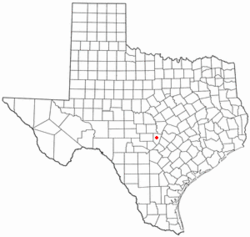Johnson City, Texas | |
|---|---|
 | |
| Motto: "The Crossroads Of The Texas Hill Country" [1] | |
 Location of Johnson City, Texas | |
 | |
| Coordinates: 30°16′27″N98°24′22″W / 30.27417°N 98.40611°W | |
| Country | United States |
| State | Texas |
| County | Blanco |
| Founded by | James P. Johnson |
| Named after | Sam E. Johnson, Sr. |
| Area | |
• Total | 1.81 sq mi (4.69 km2) |
| • Land | 1.81 sq mi (4.68 km2) |
| • Water | 0.00 sq mi (0.01 km2) |
| Elevation | 1,221 ft (372 m) |
| Population | |
• Total | 1,627 |
| • Density | 900.89/sq mi (347.83/km2) |
| Time zone | UTC-6 (Central (CST)) |
| • Summer (DST) | UTC-5 (CDT) |
| ZIP code | 78636 |
| Area code | 830 |
| FIPS code | 48-37780 [5] |
| GNIS feature ID | 2410146 [3] |
| Website | www |



Johnson City is a city and the county seat of Blanco County, Texas, United States. [6] The population was 1,627 at the 2020 census. [4] [7] Founded in 1879, it was named for early settler James Polk Johnson, nephew to Sam E. Johnson, Sr. [8] Johnson City is part of the Texas-German belt region.

